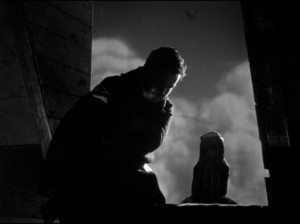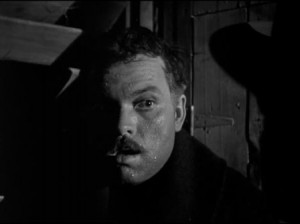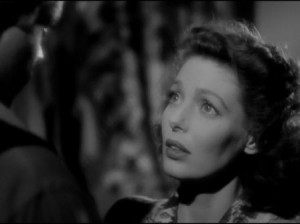 Stark music continues from the soundtrack as Rankin drags the body to a depression in the ground and covers it with leaves. Then he hears shouts as the boys return, scattering their strips of paper about the ground—and close to Meinike’s body. After the boys have disappeared into the woods, Rankin frantically retrieves the strips and spreads them in a trail away from the body.
Stark music continues from the soundtrack as Rankin drags the body to a depression in the ground and covers it with leaves. Then he hears shouts as the boys return, scattering their strips of paper about the ground—and close to Meinike’s body. After the boys have disappeared into the woods, Rankin frantically retrieves the strips and spreads them in a trail away from the body.
During the wedding, when Rankin appears unscathed by wear, or murder, Wilson regains consciousness in the gym. He goes to the pharmacy for some aspirin for his headache and loses a checker game to the sly Mr. Potter (Billy House). Wilson, however, has gained some information about his quarry from the proprietor, who proves to be the town gossip. At the church with its medieval clock and mechanical figures, Wilson hopes to find Rankin but finds instead the man’s future brother-in-law Noah (Richard Long), who says Rankin has been working on the clock, clocks being his hobby.
Posing as an antique dealer, Wilson attends a dinner that features all the principals including Mary’s father (Philip Merivale) and her brother Noah. During a discussion of the aftermath of World War II and rumors of subterranean meetings, Wilson asks Rankin if he knows Germany. Here begins the great speech of the film, a foretaste of 1949 and The Third Man “cuckoo clock” soliloquy, which Orson Welles himself wrote. Realizing that Wilson is the man Meinike was supposed to have killed, Rankin puts on an anti-Nazi face, belittling “warrior gods marching to Wagnerian strains,” “the fiery sword of Siegfried,” “banners of the Teutonic knights” and ending with an apt climax for such a speech. “Mankind is waiting for the Messiah, but for the German, the Messiah is not the Prince of Peace. He’s another . . . Barbarossa, another Hitler.” Orson Welles might well have written these words, too; both he and John Huston are uncredited contributors to the screenplay.
Later, while Rankin is in the woods killing Red, Mary’s pet dog, because the animal was pawing around Meinike’s grave, Wilson is awakened with a start (and a staccato chord and sustained trumpet note from Bronislau Kaper) and goes to the phone and calls Washington. “Well,” he confides, “who but a Nazi would deny Karl Marx was a German because he was a Jew?” Rankin’s one faux pas during that dinner conversation was the result, ironically or perhaps not so ironically, of his own hatred and bigotry. “I think,” Wilson adds on the phone, “I’ll stick around for a while.”
From here, The Stranger continues to move with the same tense excitement, the interest never slacking. In a return to the drug store, Wilson plays another game of checkers with Potter, who suggests, since the little man isn’t coming back, they examine the suitcase he left. As Wilson looks out the window at the church, he describes the contents of the suitcase as Potter removes one item at a time, unaware his guest isn’t looking. Wilson knew, of course, the contents of Meinike’s bag when he escaped the prison.
 By now everyone knows or believes Rankin is Franz Kindler, except Mary who is still in denial, even after Wilson shows her extermination camp films. Rankin partially saws through a rung in the ladder to the clock tower, then calls his wife from the pharmacy and asks her to go there. And now it’s Rankin who plays checkers with Potter, an alibi for Mary’s death. Mary is delayed and sends in her place Noah, accompanied by Wilson who almost falls when the rung breaks. Rankin is understandably surprised when he returns home to find Mary alive. “Did you kill Noah?!” she screams. “Yes,” he replies, “if he goes to the church and climbs up that ladder!”
By now everyone knows or believes Rankin is Franz Kindler, except Mary who is still in denial, even after Wilson shows her extermination camp films. Rankin partially saws through a rung in the ladder to the clock tower, then calls his wife from the pharmacy and asks her to go there. And now it’s Rankin who plays checkers with Potter, an alibi for Mary’s death. Mary is delayed and sends in her place Noah, accompanied by Wilson who almost falls when the rung breaks. Rankin is understandably surprised when he returns home to find Mary alive. “Did you kill Noah?!” she screams. “Yes,” he replies, “if he goes to the church and climbs up that ladder!”
There are stark, sometimes subtle, shots throughout the film. In one of several scenes where Rankin lies to Mary, all the camera shows of him is his hands moving nervously on the back of a church pew; in another, he is but a silhouette beside her bed and it is she who casts the dark shadow on the wall. When it’s discovered that Mary’s dog was poisoned, Wilson, Noah and the vet (Byron Keith) are seen in a reflection in the store window, reminiscent of a shot in Citizen Kane. And when Rankin is in the church tower sawing the rung, there’s a deep perspective shot from below.
Among the guests at a tea is Erskine Sanford, a kind of Orson Welles pick-up actor in a number of his films: Citizen Kane, The Lady from Shanghai, Macbeth and, perhaps most memorably, as Roger Bronson in The Magnificent Ambersons.
 Throughout, Loretta Young is the stalwart fiancée, later wife, giving one of her best performances—a well modulated crescendo to hysteria—as she gradually realizes she is married to a Nazi butcher. She provides the necessary suppressed nerves and uninhibited panic, never better, perhaps, when she is startled by something as simple as the flapping of a spent spool of film. A year later she would star in The Bishop’s Wife, much different fare to be sure, more like a Christmas fairy tale, but the role is similar: a wife feeling increasingly alienated from her husband.
Throughout, Loretta Young is the stalwart fiancée, later wife, giving one of her best performances—a well modulated crescendo to hysteria—as she gradually realizes she is married to a Nazi butcher. She provides the necessary suppressed nerves and uninhibited panic, never better, perhaps, when she is startled by something as simple as the flapping of a spent spool of film. A year later she would star in The Bishop’s Wife, much different fare to be sure, more like a Christmas fairy tale, but the role is similar: a wife feeling increasingly alienated from her husband.
Orson Welles is pretty much Orson Welles, solid and believable, and the lack of any attempt to affect a German accent seems minor in the presence of his own dramatic spectrum, from the subtlety of Meinike’s murder to his desperate shouts at Mary when he realizes the façade of his masquerade is unraveling.
In 1946, at an Alphabet City High School in Manhattan, I sat among the flotsam and jetsam of WWII. At some desks were seated unrepentant Poles and at others cringing Poles! Film awakens echos of that past time.